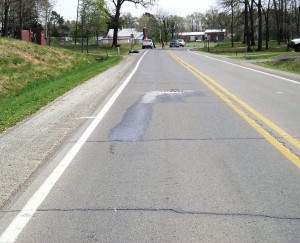
Water intrusion in unsealed cracks
What: A highly elastic material (usually a hot pour highly polymer modified asphalt) is applied to seal cracks on flexible (asphalt) and rigid (Portland Cement Concrete) pavements. Other commercial products, including cold pour fillers and sealers, are also effective. The process seals cracks against moisture and debris (incompressibles). Before sealing, the cracks should be cleaned of debris and dry. Typically, crack sealing indicates a very high quality material used in conjunction with meticulous crack preparation, while crack filling usually denotes a lower cost, cold pour material with a lower percent or no polymer modification and less rigorous crack preparation.
Where: Crack sealing is effective on all structurally sound flexible (asphalt) and rigid (PCC) pavements with good drainage and low severity surface cracking. It may be appropriate for moderate severity transverse, longitudinal, top-down and reflective cracking. Crack sealing should also be done over cracked pavements prior to surface treatments such as chip seals, micro surfacing and hot mix asphalt overlays. Crack filling is appropriate for low volume roads or where a longer lasting seal is not required.
Why (advantages): Crack sealing prevents moisture and incompressibles from intruding into pavement cracks, to prevent further crack deterioration and raveling, and to protect the pavement structure from moisture damage. Crack sealing also reduces the effects of temperature cycling on both asphalt and concrete pavements. Crack sealing is relatively inexpensive, and was shown by the Strategic Highway Research Program to be one of the most cost-effective pavement preservation treatments at retarding future degradation. Traffic return for crack sealing is quick, as soon as the sealer has cooled or cured sufficiently to avoid tracking.
Why not (disadvantages):There are very few disadvantages to crack sealing, unless a pavement has an unstable base, poor drainage or shows signs of moderate to severe fatigue cracking (which indicates structural problems). In these cases, sealing without base and/or drainage repair will only be a temporary fix.
When: Crack sealing is most effective when the pavement is structurally sound. Crack sealing should be done one year before hot mix overlays, or with sufficient curing and settling time before other resurfacing techniques.
Estimated life extension: 3-4 years over pavements in good condition; 2-3 years on pavements in fair condition; 0-2 years for pavements in poor condition.
For more information on correct crack sealing techniques, consult the Crack Seal Checklist put together by the Foundation and FHWA.
